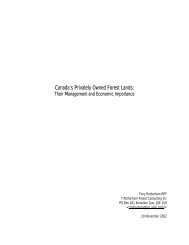A Landowner's Guide to Selling Standing Timber - the Ontario ...
A Landowner's Guide to Selling Standing Timber - the Ontario ...
A Landowner's Guide to Selling Standing Timber - the Ontario ...
You also want an ePaper? Increase the reach of your titles
YUMPU automatically turns print PDFs into web optimized ePapers that Google loves.
A LANDOWNER’S GUIDE TO SELLING STANDING TIMBERopenings in <strong>the</strong> canopy <strong>to</strong> start growing. Shade-in<strong>to</strong>lerantspecies like white birch or poplar are rarely found in <strong>the</strong>forest unders<strong>to</strong>ry. These in<strong>to</strong>lerant species becomeestablished by seed and grow <strong>to</strong> dominate <strong>the</strong> site after amajor disturbance such as “heavy” cutting or wildfire.For some species, regeneration can be accomplished on <strong>the</strong>site by one tree-cutting operation. For instance, shade<strong>to</strong>lerantspecies like sugar maple can establish and becomevigorous advance regeneration under a closed forest canopywithout intervention, and will develop once an opening in<strong>the</strong> canopy is created. The silvicultural system used <strong>to</strong>manage shade <strong>to</strong>lerant species is <strong>the</strong> selection system.O<strong>the</strong>r species with intermediate shade <strong>to</strong>lerance, like redoak and white pine, require several cutting operations <strong>to</strong>ensure successful regeneration. The first cutting operationis used <strong>to</strong> create small canopy openings, which will provide<strong>the</strong> conditions for establishment of vigorous regeneration.Sometimes <strong>the</strong> regeneration may be present, but it isdormant – it needs more light <strong>to</strong> stimulate growth.Subsequent cuts are <strong>the</strong>n used <strong>to</strong> release <strong>the</strong> seedlingsand allow <strong>the</strong>m <strong>to</strong> grow in<strong>to</strong> <strong>the</strong> dominant trees in <strong>the</strong>woodlot. The management system used <strong>to</strong> manage midshade<strong>to</strong>lerant species is <strong>the</strong> uniform shelterwood system.Table #8 provides additional information on regenerationstrategies for a number of <strong>the</strong> major tree species foundgrowing in woodlots in southcentral <strong>Ontario</strong>.Choosing a Silvicultural SystemHarvesting or silvicultural systems can be generallycategorized as ei<strong>the</strong>r an “uneven-aged” or “even-aged”system and are named after <strong>the</strong> method of <strong>the</strong> harvestingsystem used. An uneven-aged woodlot will contain trees ina wide range of ages and sizes. Normally, <strong>the</strong>re are atleast three distinct age classes present within <strong>the</strong> stand.Shade-<strong>to</strong>lerant species, such as sugar maple, beech andhemlock are most suited <strong>to</strong> being managed under thissystem. An even-aged stand is comprised of trees havingno, or relatively small, differences in age (i.e., generallywithin a 20-year range). This system is most useful in <strong>the</strong>management of shade-in<strong>to</strong>lerant species such as whitebirch, poplar and red pine.By selecting <strong>the</strong> most appropriate silvicultural system, youcan take advantage of <strong>the</strong> different shade <strong>to</strong>lerance oftrees – <strong>the</strong>reby modifying <strong>the</strong> regeneration required <strong>to</strong>meet your silvicultural objectives. The three majorsilvicultural systems used in southcentral <strong>Ontario</strong> aredescribed as follows:1. Uniform Shelterwood SilvicultureSystem – Even-agedManagement SystemThe shelterwood system is <strong>the</strong> removal of all merchantabletrees from a mature stand of timber in two or more partialharvest operations over a 20- <strong>to</strong> 40-year period thatusually results in an even-aged stand. The purpose of thissystem is <strong>to</strong> provide light conditions necessary <strong>to</strong> allow <strong>the</strong>establishment of natural regeneration and <strong>to</strong> grow treespecies which are moderately <strong>to</strong>lerant of shade such as redoak and white pine. Once <strong>the</strong> regeneration objectives havebeen met, <strong>the</strong> overs<strong>to</strong>ry is removed in stages, allowing for<strong>the</strong> fur<strong>the</strong>r development of an even-aged forest in <strong>the</strong>open-light conditions <strong>to</strong> which <strong>the</strong>se species are adapted.48
















